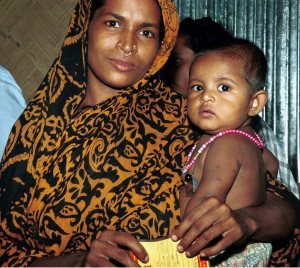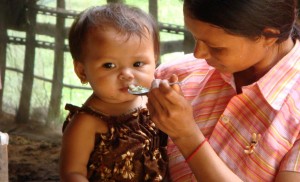
USAID's Infant & Young Child Nutrition Project
Enhanced complementary feeding programs
A common cause of inadequate child growth is poor feeding practices, particularly starting after six months of age, when children need food to complement breastmilk.
In many cases, families can feed their children adequately using locally available foods, but they often do not know how to prepare or feed these foods in a way that will meet the needs of their children. In many communities, there is also an urgent need to improve access to nutrient-rich, local foods for better complementary feeding.
We emphasized feeding for children after six months of age as a critical component of maternal, infant, and young child nutrition programming. IYCN conducted research to increase understanding of complementary feeding practices and designed social and behavior change communication and social marketing strategies to promote optimal use of nutritious local foods.
We also developed a local food supplement for HIV-positive mothers and their children and piloted an innovative method for using micronutrient powders to promote improved complementary feeding.
Piloting an innovative approach: using micronutrient powders to improve complementary feeding in Bangladesh
 To address the high prevalence of anemia among children in Bangladesh, the project designed an innovative complementary feeding intervention by coupling specific infant and young child feeding practices promoted by the Ministry of Health with the use of micronutrient powders for home fortification. In collaboration with CARE, the project led a consensus-building workshop with nutrition stakeholders to select specific target practices to promote—such as the addition of mashed vegetables to complementary foods—and created communications materials to assist community health workers in promoting these practices along with the use of micronutrient powders, supplied by the Global Alliance for Improved Nutrition. The intervention reached more than 55,000 young children in the country’s Karimganj District. CARE will evaluate its impact both on anemia prevalence and infant and young child feeding practices.
To address the high prevalence of anemia among children in Bangladesh, the project designed an innovative complementary feeding intervention by coupling specific infant and young child feeding practices promoted by the Ministry of Health with the use of micronutrient powders for home fortification. In collaboration with CARE, the project led a consensus-building workshop with nutrition stakeholders to select specific target practices to promote—such as the addition of mashed vegetables to complementary foods—and created communications materials to assist community health workers in promoting these practices along with the use of micronutrient powders, supplied by the Global Alliance for Improved Nutrition. The intervention reached more than 55,000 young children in the country’s Karimganj District. CARE will evaluate its impact both on anemia prevalence and infant and young child feeding practices.
Highlights
- IYCN increased understanding of complementary feeding practices by publishing a global literature review and by conducting formative assessments in nine countries.
- In 13 countries, IYCN emphasized that local foods can contribute to improved complementary feeding of children. For example, the project created local recipe books and trained community workers and volunteers in Côte d’Ivoire, Ethiopia, Malawi, and Zambia to conduct cooking demonstrations using available resources to promote more nutritious meals for children.
- Together with partners, IYCN reached 55,000 young children in Bangladesh with an innovative intervention promoting improved complementary feeding practices and encouraging use of micronutrient powders to prevent anemia.
- As part of a public-private partnership with the Global Alliance for Improved Nutrition, the government of Ghana, and Yedent Agro, a local food manufacturer, the project developed and implemented a social marketing strategy to promote improved complementary feeding practices and encourage use of fortified complementary foods for children. The intervention reached households in the Brong Ahafo Region with complementary feeding messages by airing more than 1,000 radio spots, distributing nearly 6,000 posters and more than 19,000 flyers, and training 196 health workers and 137 community group leaders to conduct community activities.
- In Zambia, the project developed a lipid-based, add-in food supplement for HIV-positive mothers and their children. A manual is available to help manufacturers in Zambia and other countries replicate the formula using local resources.
Photo: Ram Shrestha, M. Dorgabekova


